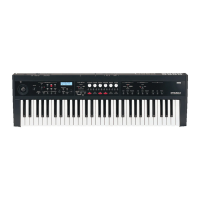Performance edit A performance’s structure and settings
27
Performance edit
A performance’s structure and
settings
A performance consists of the sound sources “main
timbres” and “sub timbres,” and the “master effect”
and “EQ” sections that apply effects to the overall
sound and adjust its tonal character.
A “program” is assigned to each timbre; “tone
parameters” adjust the sound of this program, and
“timbre parameters” specify how the timbre will
operate.
Each program (except for the STRINGS timbre) has
one “insert effect.” Insert effect settings are made in
Program Edit mode.
Major performance edit
parameters
Tone parameter adjustments
Each timbre has eight tone parameters (located in
“Filter/Amp:” and “Filter/Amp EG:”); these allow you
to make overall adjustments to the brightness, attack,
and decay speed of the selected program (p. 31).
Timbre parameter settings
You can make the following settings for each timbre.
• Adjust the volume and pan.
“Volume,” “Pan (Pre),” “Pan (Post)” (p. 30)
• Adjust the pitch/tuning.
“Octave,” “Transpose,” “Detune” (p. 31)
• Switch the portamento on/off and adjust its speed.
“Portamento” (p. 31)
Portamento is a function that creates a smooth
change in pitch between notes when you play a note
before releasing the previous note.
• Specify the amount of pitch change that can be
produced by moving the joystick to left or right.
“Bend Range” (p. 31)
• Specify whether the damper effect will be applied
to each timbre.
“MIDI Filter:” (p. 32)
• Specify whether each timbre can be played by an
external MIDI device, or whether each timbre can
play an external MIDI sound module.
“Status” (p. 30)
A.PIANO
MAIN TIMBRES
SUB TIMBRES
Tone ParametersTimbreParameters
Program
AUDIO OUTPUT
L/MONO, R
L/MONO, R
SEND1
SEND2
E.PIANO
Tone ParametersTimbreParameters
Program
L/MONO, R
SEND1
SEND2
ORGAN
Tone ParametersTimbreParameters
Program
L/MONO, R
SEND1
SEND2
STRINGS
Tone ParametersTimbreParameters
Program
L/MONO, R
SEND1
SEND2
BRASS
Tone ParametersTimbreParameters
Program
L/MONO, R
SEND1
SEND2
SYNTH
Tone ParametersTimbreParameters
Program
L/MONO, R
SEND1
SEND2
MODULATION
EQ
REVERB/DELAY
Chain
On/O
Return1Return2
Master
Volume
IFX
IFX
IFX
IFX
IFX
Structure of a performance
(used only with split settings)

